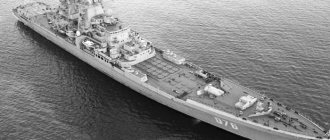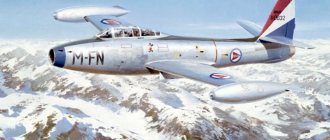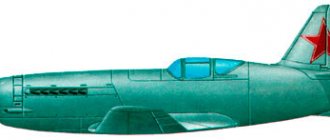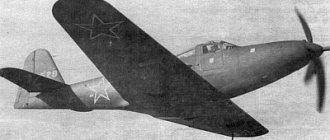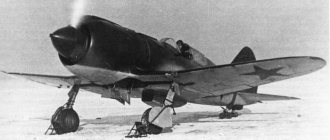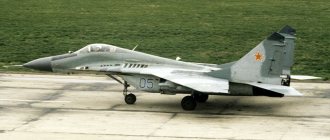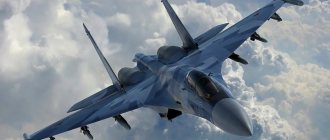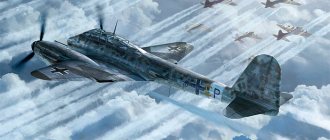Long-range reconnaissance Luftwaffe Dornier Do-215
The Dornier Do-215 twin-engine monoplane of all-metal construction was conceived as an export version of the Do-17Z aircraft. The meaning of assigning the new designation Do 215 to the aircraft is not entirely clear - after all, the aircraft was not fundamentally different from the Do 17Z, the difference was only in the type of engines installed. Perhaps this was a kind of “marketing ploy” on the part of the manufacturer.
Three Do 17Z-0 aircraft from the pre-production batch were used as Do 215 prototypes. The first of them (Do 215V1) was equipped with BMW 132N engines, the second (Do 215V2), which was offered to Yugoslavia, was equipped with Gnome-Ron GR 14NO engines, and the third (Do 215V3), which was tested in the spring of 1940, was equipped with 12-cylinder liquid-cooled motors DB 601A (1075 hp). Orders were received from Yugoslavia for 40 aircraft (assembled in Yugoslavia) with Jumo 211 engines and from Sweden for 18 Do 215A-1 aircraft with DB 601A engines. However, none of these vehicles ever made it abroad: the supply of components for assembly in Yugoslavia began only in April 1940, shortly before the occupation of the country, and the Swedish-ordered vehicles were confiscated by the Luftwaffe after the outbreak of World War II.
Production of the aircraft under the designation Dornier Do-215B for the Luftwaffe continued at a slow pace until the beginning of 1941. A total of 101 (according to other sources, 105) aircraft were produced in Oberpfaffenhofen.
Creation of the Dornier 215 bomber (Dornier-215)
When the German Dornier 17 medium bomber was demonstrated in Zurich in 1937, representatives of the air forces of other European countries also became interested in the new product. The following year, 1938, Dornier designers developed an export version of this bomber, which received its own designation: Dornier-215 (Do-15) . Structurally, the new bomber was the same Do-17 (model Do-17Z-0), but the armament and power plant could differ, depending on the customer country.
In the fall of 1939, the first contract was concluded with Sweden for the supply of 18 Do-215A-1 aircraft, but even before deliveries began, a ban was imposed on the export of the bomber. The aircraft were converted into long-range reconnaissance aircraft and entered service with the Luftwaffe under the designation Do-215B-0 and B-1. In April 1940, these aircraft already took part in hostilities in Norway, and subsequently Do-215s were produced only for the German army.
Dornier 215 (Do-215) bomber projections
Production of the Dornier-215 continued from 1938 until early 1941. A total of 101 aircraft of all modifications were produced.
Surviving aircraft[edit]
Until recently, it was believed that none of the Dornier twin-engine bomber variants survived. In September 2007, a Dornier Do 215 B was found virtually intact in the shallow waters of the Wadden Sea, Netherlands. This aircraft was flown by Luftwaffe fighter ace Helmut Woltersdorf. On the night of 6–7 July 1941, Woltersdorf shot down a Vickers Wellington, but its Dornier was damaged by return fire and crash-landed off the coast of the Netherlands. [6] The area where Dornier descended was designated a seal sanctuary and thus escaped the notice of scrap metal dealers and souvenir hunters. At low tide the plane becomes visible.
The aircraft restoration team at the aviation museum at Fort Veldhuis [nl] in Heemskerk has been given permission to partially recover the Do 215. The only missing part of the aircraft is the tail section, which is 70 ft (21 m) from the main body. debris. The Daimler-Benz DB 601 engines were restored along with the right side of the cab. [7]
Design and modifications of the Dornier 215 bomber
The Do-215 bomber is a cantilever mid-wing with a two-tail tail, similar in design to the Dornier-17. The chassis was tricycle with a tail wheel, the power plant consisted of 2 liquid-cooled Damler-Benz DB-601A V-shaped piston engines. To increase the flight range, an additional 775 liter fuel tank could be installed in the bomb bay. Some aircraft (only in the fighter version) were equipped with FuG-202 Liechtenstein-VS locators.
Bomber Dornier-215
- Do-215V1 (aka Do-17Z-0 ) - prototype.
- Do-215V2 - 1938, prototype for Yugoslavia with air-cooled Gnom-Ron-14H1/2 radial engines.
- Do-215V3 - 1939, prototype with Damler-Benz DB-601A liquid-cooled engines.
- Do-215A-1 is a production version of the Dornier 215 bomber.
- The Do-215B-1 is a long-range reconnaissance aircraft into which all previously produced Do-215A-1s were converted.
- Do-215B-2 is a bomber project.
- Do-215B-3 - 1940, prototype in the version for the USSR. 2 aircraft were produced.
- Do-215B-4 - reconnaissance bomber with cameras.
- Do-215B-5 is a night fighter with an infrared radar (thermal imager) “Spanner-anlag. Armament: 4x MG-17 and 2x MG-FF machine guns in the forward fuselage. 20 aircraft of this type were manufactured, and starting in the fall of 1940, the previously produced Do-215B-4 .
Links[edit]
- Griehl (2005), p. 10.
- Griehl (2005), p. 11.
- Novarra, Heinz J. "The Flying Pencil: Dornier Do 17 and Do 215." Schiffer Military History
.
25
. ISBN 0-88740-236-4. - Green 1967, p.10
- Nowarra 1990, p. 37.
- Air Parade
, No. 315, October 2007, p. 62 - Air Parade
, No.315, October 2007, p. 63. - Green, William (2010). Aircraft of the Third Reich Volume One
. London: Crecy. pp. 255–257. ISBN 9781900732062. - Smith, Jr.; Kay, Anthony L. (1972). German aviation during World War II
. London: Putnam. pp. 126–127. ISBN 978-0-85177-836-5. - Gladniker, David. "An Incomplete Guide to Using an Airfoil". m-selig.ae.illinois.edu
. Retrieved April 16, 2022.
Characteristics of Dornier Do.215
A country:GermanyType:BomberYear of issue:1938Crew:4 peopleEngine:2x DB-601A, 1100 hpMaximum speed:467 km/hPractical ceiling:9000 mRange of flight:2400 kmEmpty weight:5780 kgMaximum take-off weight:8800 kg (normal takeoff)Wingspan:15.8 mLength:18 mHeight:4.6 mWing area:53.3 sq.m.Weapons:6x 7.92 mm MG-17 machine guns (2 forward, 1 each at the top and bottom, 2 in the side windows), 1000 kg bomb load
Combat aircraft. Loser Eagles of the Luftwaffe
Finishing the conversation about the aircraft of the 17th family of the Claudius Dornier company, it is impossible not to say a few words about reconnaissance aircraft, which were a separate detachment that could have good prospects.
However, something went wrong... In general, the development of aircraft in the interwar period was strange. Mainly because it was not fighters, but bombers that were at the forefront of development. Since this class of aircraft was not as limited in size and weight as fighters, new items such as retractable landing gear, cantilever wings, the number of which became smaller, aerodynamic delights, and so on began to appear en masse on bombers. As a result, some bombers began to overtake biplane fighters.
And then the concept of a “high-speed bomber” was born, which does not need to be burdened with defensive weapons. The plane will simply move away from the enemy due to its speed.
It’s clear that I couldn’t help but like the idea. And the basis for execution was taken, if not a separate project, then a passenger airliner, whose interior was simply replaced with a compartment with bombs. This is how one of the main losers of World War II appeared, the Bristol Blenheim, the Italian Savoia-Marchetti S.79, and the German Dornier 17.
Dornier Do.17
The Do.17 was a very modern aircraft and was an all-metal top-wing monoplane.
The long, narrow fuselage had a duralumin frame and smooth metal skin. The radiators were deeply hidden inside the engine nacelle engine compartment, so their cross-section was small. During flight, the main landing gear was completely retracted inside the engine nacelles, and the tail wheel was retracted into the fuselage along with the fairing. The eighth prototype of the aircraft was built specifically as a long-range reconnaissance aircraft with the ability to carry out a bomb strike. The aircraft itself was very different from its bomber counterparts in terms of the cockpit layout in light of the tasks assigned to the reconnaissance aircraft.
If the Do.17E bomber was called a “flying pencil,” then its reconnaissance brother did not at all resemble a pencil.
The nose has become larger and rounded. The glazing was made more extensive for both the pilot and the navigator, who was assigned observer duties. In place of the first passenger cabin of the original Do.17 version, a radio room was equipped with a radio operator’s workplace and a set of radio equipment. A blister rifle mount with an MG.15 machine gun appeared above the wheelhouse, from which, if necessary, the radio operator, who also became a shooter, could repel attacks from the rear hemisphere.
It was believed that the high speed of a scout was his main trump card in confronting enemy fighters, therefore one machine gun “just in case” would be enough.
In place of the second passenger cabin, two or three cameras were placed between the wing spars, depending on the model.
The Dornier long-range reconnaissance aircraft was named Do.17F-1. The main difference from the bomber was the absence of bomb release mechanisms and a bomb sight. Instead of bomb racks, another fuel tank was installed in the compartment, and Rb 10/18, Rb 20/30 or Rb 50/30 cameras were placed below, at the bomb position.
The aircraft was “tested” in Spain, during the Civil War, as part of the Condor Legion. The 15 scouts greatly enhanced Franco's army's intelligence-gathering capabilities.
Here it turned out that Polikarpov’s I-16 fighter, although “grindingly,” was catching up with the Do.17. 390 km/h for the I-16 versus 355 km/h for the Do.17 is a small but advantage. Once an aircraft has appeared that can catch up with a reconnaissance aircraft (or a high-speed bomber), then something needs to be done about it.
But it should be noted that the losses of Do.17F-1 reconnaissance aircraft in Spain were mainly from anti-aircraft fire, which confirms the high speed qualities of the reconnaissance aircraft. During the year of using the Do.17F as a reconnaissance aircraft, Franco’s army shot down only 2 aircraft, in return for which the Germans politely provided 10 more aircraft of the next modification of the Do.17P.
The armament had to be strengthened to three MG.15 machine guns. A course machine gun appeared, from which the pilot or navigator could fire, and another machine gun at the radio operator, which fired back and forth through the hatch in the cockpit floor.
In general, if there were enemy fighters in the air, the radio operator’s job was over.
Despite the obvious shortcomings in terms of armament and distribution of responsibilities between crew members, the Do.17 was liked by the highest ranks of the Luftwaffe and a decision was made to re-equip all reconnaissance squadrons with this aircraft. The frankly unsuccessful Heinkel 70 had to be replaced with a more modern aircraft at the time it was put into service.
Spanish combat tests confirmed the opinion of Luftwaffe leaders that the Do.17F is what is needed. And work began on the Do.17P modification, which was the next in the development line.
It entered the Do.17R series in 1938. The main difference was the replacement of engines with air-cooled motors from BMW. The proportion of metal in the design of the planes was increased, which gave an increase in speed. Do.17R developed 410 km/h at 4000 m.
Due to the use of thicker air-cooled engines, the chassis track has increased, which cannot be called a minus. The Do.17P was equipped with only two Rb 50/30 or Rb 75/30 cameras, and the place of the third camera was taken by an enlarged gas tank. In total, the fuel supply on the Do.17R amounted to 2120 liters and significantly increased the range, which amounted to 675 km.
The weapons also underwent changes. Instead of a conventional pin turret, a lens unit was installed on top of the fuselage. The two points for firing downwards, backwards and forwards remained unchanged, but on later Do.17P aircraft a fourth firing point appeared, the MG.15 machine gun, which fired forwards and downwards through a cutout in the front glazing of the cockpit.
Aircraft with such a set of weapons took part in the initial stage of the Second World War.
The Do.17P aircraft were produced until the end of 1938, until they were replaced by the next modification - the Do.17Z. A total of 330 Do.17Ps were produced. For a scout this is a very, very impressive figure.
It is worth noting the special upgrades, the long-range maritime reconnaissance Do 17Р-1/U1, which was equipped with a compartment with an inflatable lifeboat and a large emergency kit, and the Do.17P-1/Trop, which was equipped with dust filters, desert equipment and an additional water tank for 50 liters.
Based on the Do.17P, a pilot series of four aircraft was created with water-cooled DB.601A engines with direct fuel injection. These were very serious machines, the maximum speed was 532 km/h, the flight range was 2250 km.
For certain reasons (demand for DB.603 engines for fighter aircraft), the aircraft did not go into production, and four manufactured copies were placed at the disposal of Rovel’s special air reconnaissance group.
Do.17F and P reconnaissance aircraft served in specialized squadrons until the very end of the war.
About 20 scouts were sold to Bulgaria. 12 aircraft took part in operations of German and Italian forces in the Mediterranean Sea. Bulgarian Dorniers escorted Italian and German ships carrying various cargoes to North Africa, and also carried out aerial photography of minefields in the Aegean and Mediterranean seas.
After the “turnaround” of Bulgaria on September 8, 1944, the Bulgarian Dorniers, along with their crews, were part of the Soviet aviation, where they were used as reconnaissance aircraft.
Dornier Do.215
The history of the appearance of this aircraft is interesting.
When the Do.17Z modification appeared, the Swedes wanted to buy this aircraft, to whom the French had refused to fulfill a previously concluded contract for Breguet-694 aircraft. "Mistral", but in the 20th century.
The German Ministry of Aviation gave permission for export, but to avoid confusion, assigned the aircraft a new name. Do.215a-1 was completely identical to Do.17Z.
But the Swedes were unlucky twice, because when a batch of 18 bombers was ready, an export ban was imposed. And these bombers were urgently converted into reconnaissance aircraft and included in the Luftwaffe under the name Do.215b-1.
There was even a modification of the Do.215b-4, in which the aircraft carried only two cameras, the Rb-50/30 was mounted under the lower gun mount, and the Rb-20/30 was mounted on the entrance hatch. But in the compartment it was possible to hang 5 bombs of 50 kg each, and when flying over short distances - 10 such bombs.
Defensive armament consisted of two MG-15 machine guns firing forward, two of the same machine guns in the side windows of the cockpit, and two machine guns in the upper and lower rear positions.
The crew was finally increased by one person and consisted of a pilot, a navigator and two gunners, one of whom also served as a radio operator.
Limited production of the Do.215b continued until early 1941, with a total of 101 aircraft produced.
Our specialists purchased two such aircraft in 1940 and carefully studied them at the Air Force Research Institute.
A lot of interesting things came to light. It turned out that the Germans, to put it mildly, were lying. The maximum speed at the ground was 30 km/h lower, and at an altitude of 4500 meters it was almost 50 km/h lower. The time to climb to 3000 m was 6.2 minutes instead of the stated 5.2.
On the other hand, a set of an excellent FuG-10a radio station, an EZ-3 radio half-compass, blind landing equipment and a SAM autopilot made this aircraft very interesting for pilots.
According to the pilots, the aircraft was easy to pilot, had excellent visibility, and the equipment for “blind” and night flights made it possible to operate it at any time of the day and in difficult weather conditions.
The glass nose provides excellent visibility forward, down, to the sides and rear. The flight test report noted:
“If there is a good overview and the entire crew is located together, the enemy can be quickly detected and the entire crew notified instantly.”
Training air battles between Do.215 and I-153 and I-16 fighters were carried out. As a result, it turned out that the German aircraft was virtually defenseless when attacked from the front below and from the front right, and the interaction of fire between the hemisphere of the front and rear firing points of the aircraft during attacks in the front was impossible. When the fighter exits the attack towards the tail of the Do-215 aircraft, short-term firing is possible from the upper rear or hatch installation. The use of weapons from the top, rear and hatch firing points is possible for all attacks in the rear hemisphere, but the angles of fire of the attacking aircraft are limited.
Soviet experts gave recommendations to the pilots that “for the Do.215, the most vulnerable and undefended sectors are the completely left lower sector in front and on the right above and below at angles of more than 20 degrees, as well as in the rear directly under the tail from the stabilizer and below - up to 25- 30 degrees. In the indicated sectors, the attacking fighter cannot be fired upon by any of the rifle installations.”
It was also noted that
“The plane has excellent forward visibility and excellent conditions for bombing. The fulfillment of navigational tasks is ensured by the availability of good air navigation equipment. The Do.215 aircraft can successfully perform reconnaissance missions, both visually and using aerial photography.”
Do.215 aircraft were used as long-range reconnaissance aircraft throughout the war.
Dornier Do.217
This aircraft appeared due to the fact that aircraft designers received a new BMW 801 engine, more compact and powerful.
1580 hp The new engine promised a very decent increase in the aircraft's performance. The Do.217 bomber turned out to be quite good, except for the fact that it was never taught how to dive. With the scout, everything turned out a little differently. In general, work on reconnaissance models was never stopped, and there were many projects. Do.217M-8, which did not go into production, Do.215V-6 with DB 601T engines, Do.217A-0 with DB 601R engines, Do.217L with DB 603N engines and the GM1 boost system. According to calculations, the Do.217L could reach a speed of 575 km/h and gain an altitude of 15,000 m. The aircraft was not produced due to the lack of development of the DB 603H engines, which, despite the power of 2000 hp. turned out to be very capricious.
But there was a very interesting reconnaissance bomber Do.217R in pre-production. The plane was actually three-engine, with two DB 603B engines producing 1,750 hp. They added a third DB 605T engine with a power of 1400 hp inside the fuselage, in the bomb bay, which acted as a central pressurization unit, increasing the air pressure at the inlet to the main engines when flying at high altitudes.
The idea itself is not new; it was used in our country on the TB-7/Pe-8 in the mid-30s. But the Germans managed to create a good pressurized cabin for three people, something that Soviet designers failed to achieve.
During testing, Do.217PV1 easily climbed to a height of 11,300 m, and the crew did not experience any discomfort at all, which was noted in the reports. Subsequently, a larger wing was installed.
The Do.217P had to enter into competition with the aircraft from Henschel, the Hs.130. The developments of the two companies were carried out in parallel, but Henschel was a new generation machine and would not have been able to get into production as quickly as the brainchild of Dornier. The Allies set the final point in the programs for the creation of both aircraft: during the raid on Stuttgart, both Dornier Do.217P prototypes and both Henschel Hs.130 prototypes were destroyed.
Three pre-production Do.217R-0 aircraft were built and transferred for testing to Rechlin.
It was actually interesting with them: a pressurized cabin is great, but what about machine guns? Hatch, lens, and window installations for pressurized cabins are completely unacceptable. You need a hole in the glass through which the barrel will stick out!
In general, the problem could be solved with the help of remotely controlled installations, but this was too much of a complication. Therefore, we made a compromise: the Do.217Р-0 was armed with three MG.81Z twin guns in standard nose, rear upper and lower settings.
When the plane reached its operating altitude, the machine guns were retracted inside, and the embrasures were closed with sealed hatches. During descent, when cabin pressurization was not required, the embrasures opened and weapons could be used.
It was believed (quite rightly) that at altitudes above 8,000 meters the likelihood of encountering enemy fighters would be extremely low.
The reconnaissance equipment of the Do.217R-0 consisted of three aerial cameras instead of the two of its predecessor - one Rb 20/30 and two Rb 70/30. Since the pressurization unit was located in the former bomb bay, two suspension units were equipped under the wings, on which either two additional fuel tanks of 900 liters each, or two bombs of 500 kg each could be carried.
The company planned to produce two versions of the Do.217R high-altitude reconnaissance aircraft. The first corresponded to the Do.217R-0, the second version of the R-2 was distinguished by a large wing of as much as 100 square meters. m.
The plans were not implemented because at the end of the war, intelligence officers were no longer in such demand.
In general, everything was difficult with Dornier aircraft. The Do.217 was at least not inferior in performance characteristics to the Ju.88 and definitely superior to the He.111. However, production of Junkers and Heinkel aircraft dominated, and Dornier aircraft were built in addition. Therefore, not many reconnaissance aircraft were produced; only 346 reconnaissance aircraft.
On the other hand, reconnaissance aircraft are far from the most numerous class of aircraft, so here we can say that Dornier’s work was quite successful. Numerous detailed photographs of the territory of the USSR captured after the war are proof of this. Thanks to these photographs, the Germans always had the most detailed maps at their disposal, and this was the undoubted merit of these aircraft.
LTX Do.217p-0:
Wingspan, m: 24.50. Length, m: 17.85. Height, m: 5.00. Wing area, sq. m: 65.00.
Weight, kg: — normal take-off: 14,350; — maximum takeoff: 15,980.
Engine: 2 x Daimler-Benz DB-603A (with compressor based on DB-605T) x 1750 hp. Maximum speed, km/h: 580. Maximum rate of climb, m/min: 290. Service ceiling, m: 15,500. Crew, people: 3. Armament: - four 7.92 mm MG-81 machine guns - two forward, one back in the upper and lower settings; - two 500 kg bombs under the wing.
Combat use of Dornier-215
The Do-215's life was short, and the aircraft were primarily used as reconnaissance aircraft rather than bombers. By 1942, all Dorniers were transferred to the training and test category, where they served until 1944. In addition to Germany, Hungary had the 4th Do-215, which used these vehicles as reconnaissance aircraft until 1945.
• Aviation Directory • Aircraft of the same period • German Bombers •
Source: compilation from open sources on the Internet, as well as from the book “Fighters of the Second World War 1939-1945”. AVIAM, 1994
Operators[edit]
Dornier Do 215
Wartime operators Germany
- Luftwaffe
Hungary
- The Royal Hungarian Air Force [4] operated at least 11 aircraft.
Soviet Union
- The Soviet Air Force purchased two aircraft from Germany. [5]
Planned operators Sweden
- The Swedish Air Force ordered 18 Do 215 A-1s, but these aircraft were embargoed and transferred to the Luftwaffe.
Kingdom of Yugoslavia
- The Yugoslav Air Force ordered the Do 215, but due to the outbreak of World War II the order was never completed.
Netherlands
- In the summer of 1939, the Luchtvaartafdeeling (Dutch Air Force) planned to purchase 24 aircraft to replace the Fokker TV, which had problems with the reliability of its engines and propellers.
Bibliography[edit]
- Dressel, Joachim; Grill, Manfred (1994). Luftwaffe bombers
. London: arms and armor. ISBN 1-85409-140-9. - Grill, Manfred (2005) [1991]. Dornier Do 17 EZ, Do 215 B: flying pencil in Luftwaffe service
. Erlangen, Germany: AirDOC. ISBN 3-935687-42-7. - Kulikov, Victor (March 2000). “Des events en or pour Staline, ou les avions allemands en URSS” [Golden opportunities for Stalin, or German aviation in the USSR]. Avions: Toute l'Aéronautique et son histoire
(in French) (84): 16–23. ISSN 1243-8650. - Kulikov, Victor (April 2000). "For cases or for Stalin, or for other purposes in URSS." Avions: Toute l'Aéronautique et son histoire
(in French) (85): 44–49. ISSN 1243-8650. - Olrog, Mikael (2017). Dornier Do 215: from reconnaissance aircraft to night fighter
. Manchester, UK: Crecy Publishing. ISBN 978-1-90653-752-4. - Green, William (1967). Combat Aircraft of World War II, Volume Nine, Bombers and Reconnaissance Aircraft
. London: Macdonald. ISBN 978-0-356-01491-3.
see also
Related developments
- Dornier U17
- Dornier Do 217
- Dornier Do 317
Similar aircraft
- Bristol Blenheim
- PZL.37 Elk
- Tupolev SB
Notation sequences
- RLM aircraft designation system: ← Hü 211 · Sun 212 · Sun 214 · Sun 215
· Sun 216 · Sun 217 · Hs 217 →
related lists
- List of German military aircraft in World War II
References
- Grill 2005, p. 10.
- Heinz, J. Nourra. Flying Pencil - Dornier Do17 and Do 215
. Schiffer's Military History, Volume 25. ISBN 0-88740-236-4. - Green 1967, p. 10.
- Flypast
, issue 315, published October 2007, p. 62. - Flypast
, issue 315, published October 2007, p. 63. - Smith Jr. (1972). German aviation of World War II
. Londonres: Putnam. ISBN 0851778364.
- Combat Aircraft of the Second World War, Volume 9, "Bombers and Reconnaissance Planes" by William Green, published by Macdonald in 1967 in London, pages 7–11. ISBN 0356 014916.
Design and development
The fast bomber Dornier Do 17 attracted the interest of foreign air forces (after the start of mass production of the Do-17K). Therefore, in July 1937, Dornier prepared a pre-production batch of Do 17 Z-0 as demonstration units for export to potential customers. It was given civil registration D-AAIV. Although the aircraft was essentially identical to the Do 17Z, the Reichsluftfarthministerium
assigned the designation
Do 215
.
The V1 prototype retained the Bramo 323 Fafnir
from the Do 17Z.
The second prototype (Do 215 V2) was powered by Gnome-Rhône 14-NO radial engines. Although it completed trials safely, it did not attract orders from abroad as it did not offer significant improvement in capability over the Do 17Z. Dornier then equipped the V3 prototype with Daimler-Benz DB 601 Ba inline engines producing 1,159 hp. (1175 hp). The V3 first flew in 1939 and demonstrated a marked improvement in flight performance over earlier prototypes.
Serial production of Do 215 A-1
started in 1939, commissioned by the Swedish Air Force Fygvapen, and was stopped in August 1939 due to the political situation. The 18 aircraft under construction were requisitioned by the German government and incorporated into the Luftwaffe following the outbreak of hostilities in World War II.
Some modifications were made to the aircraft, which were renamed Do 215B
. This was the production standard for the production version. Between 1939 and 1941, between 92 and 105 were produced (according to sources).
